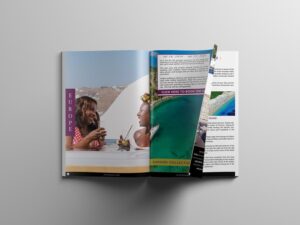
Travel brochure itinerary infographics serve as a vibrant canvas that transforms ordinary travel plans into visually appealing guides. By blending essential information with engaging visuals, these infographics not only capture attention but also facilitate an easier navigation experience for travelers.
As travel continues to evolve, incorporating infographics into brochures has become vital in presenting information clearly and creatively, making it easier for travelers to grasp itineraries, attractions, and important advisories at a glance.
Travel Brochure Basics
Travel brochures serve as vital tools for promoting destinations, providing essential information, and captivating potential travelers. They combine visual appeal with informative content to create enticing narratives around various travel experiences.
Essential Elements of a Travel Brochure
A well-crafted travel brochure typically contains several key elements that contribute to its effectiveness. These include:
- Compelling Imagery: High-quality photos of destinations, activities, and accommodations attract attention and inspire wanderlust.
- Engaging Copy: Concise and persuasive text that highlights unique features, experiences, and attractions is essential for enticing readers.
- Contact Information: Clear details on how to book or get more information, including phone numbers, email addresses, and website links.
- Maps and Directions: Visual aids that help travelers understand the geography of the area in relation to attractions and accommodations.
Role of Infographics in Enhancing Travel Brochures
Infographics play a crucial role in travel brochures by simplifying complex information and making it visually engaging. They can include:
- Statistics: Quick facts about visitor numbers, average temperature, or travel costs.
- Timelines: Suggested itineraries or timelines for the best time to visit.
- Icons: Visual representations of amenities or attractions, which make it easier for readers to absorb information.
Formats and Designs in Travel Brochures
Travel brochures come in various formats and designs to cater to different audiences and purposes. Common formats include:
- Tri-Fold Brochures: A classic design that allows for a clean layout and easy folding.
- Booklets: Suitable for extensive information, these provide a more detailed exploration of a destination.
- Digital Brochures: Increasingly popular, these allow for interactive elements and can be easily shared online.
Creating an Effective Travel Itinerary
Designing a travel itinerary is an essential part of travel planning, ensuring that travelers can maximize their time and experiences. A well-organized itinerary can enhance the travel experience and reduce stress.
Steps for Designing a Comprehensive Travel Itinerary
Creating an effective travel itinerary involves several steps that help organize travel plans efficiently:
- Set Objectives: Determine what you want to achieve during the trip, whether relaxation, adventure, or cultural exploration.
- Research Destinations: Gather information about potential destinations, attractions, and local customs.
- Allocate Time: Decide how much time to spend at each location, allowing for travel time and unexpected events.
- Document Everything: Write down all essential details, including addresses, contact numbers, and opening hours of attractions.
Incorporating Infographics for Easier Navigation
Using infographics can significantly enhance the usability of a travel itinerary. Consider including:
- Maps: Visual maps indicating travel routes, points of interest, and accommodations.
- Flowcharts: Diagrams that Artikel daily activities in a clear, easy-to-follow format.
- Icons: Use icons to denote different types of activities, such as dining, sightseeing, or outdoor adventures.
Best Practices for Presenting Travel Times and Attractions Visually
Visual representation of travel times and attractions can make itineraries more accessible:
- Timelines: Create visual timelines to show the sequence of activities and travel durations.
- Color Coding: Use different colors for various categories of activities to visually separate them.
- Charts: Bar charts or pie charts can summarize time allocations or budget considerations effectively.
Travel Advisory Insights
Travel advisories are critical resources that inform travelers about safety, health, and security risks associated with specific destinations. Understanding these advisories is essential for responsible travel planning.
Definition and Importance of Travel Advisories
Travel advisories are official notifications issued by governments or organizations that Artikel the safety conditions of a travel destination. They serve to alert travelers to potential risks, allowing them to make informed decisions about their travel plans.
Finding Updated Travel Advisories for Various Destinations
Travelers can access up-to-date travel advisories through multiple sources, including:
- Government Websites: Many countries provide travel advisories on their official government or embassy websites.
- Travel Agencies: Reputable travel agencies often stay informed about the latest advisories and can provide guidance.
- Social Media and News Outlets: Following travel blogs or news outlets can provide real-time updates and insights.
Implications of Travel Advisories on Planning Itineraries
Travel advisories can significantly impact travel planning. Key considerations include:
- Destination Selection: Travelers may choose to avoid destinations with high-risk advisories.
- Activity Adjustments: Activities may need to be altered or canceled based on safety recommendations.
- Insurance Requirements: Some insurance providers may require awareness of advisories when issuing coverage.
Role of a Travel Advisor
Travel advisors play a crucial role in simplifying the travel planning process, providing expert advice and personalized service to travelers.
Responsibilities of a Travel Advisor in Itinerary Planning
Travel advisors are responsible for:
- Consultation: Meeting with clients to discuss preferences, budgets, and travel goals.
- Research: Conducting thorough research to identify suitable destinations and accommodations.
- Booking Services: Facilitating all necessary bookings for flights, hotels, activities, and transportation.
Differences Between Travel Advisors and Travel Agents
While both professionals assist in travel planning, their roles differ:
- Focus on Service: Travel advisors typically provide personalized service, while travel agents may focus more on transactions.
- Expertise: Travel advisors often have niche expertise and can tailor experiences specifically to client needs.
- Post-Booking Support: Advisors often offer continued support throughout the journey, addressing any concerns that may arise.
Tips for Selecting a Reliable Travel Advisor
Choosing the right travel advisor is crucial for a seamless travel experience. Consider the following tips:
- Check Credentials: Look for certifications and memberships in professional organizations.
- Read Reviews: Research past client testimonials and reviews to gauge satisfaction levels.
- Assess Communication: Ensure the advisor communicates clearly and responds promptly to inquiries.
Travel and Leisure Trends
The travel industry is in constant flux, with trends emerging that influence how brochures are designed and what content is included.
Current Trends Influencing Brochure Design
Recent trends in travel and leisure are shaping brochure aesthetics and content:
- Sustainability: A focus on eco-friendly travel options is becoming more prevalent in brochures.
- Personalization: Tailored experiences are highlighted, catering to individual traveler preferences.
- Technology Integration: Many brochures now include QR codes linking to interactive content or booking options.
Popular Destinations Featured in Modern Travel Brochures
Certain destinations have gained popularity and are frequently featured in contemporary travel brochures:
- Iceland: Known for its stunning natural landscapes and outdoor adventures.
- Japan: Celebrated for its rich culture, technology, and culinary experiences.
- Italy: Renowned for its historical sites, art, and diverse regions.
Impact of Travel Blogs on Travel Brochure Content
Travel blogs have a significant influence on the travel industry, including brochure content. They provide:
- Authentic Perspectives: Personal experiences shared by bloggers can enhance the credibility of destinations.
- Innovative Ideas: Bloggers often highlight unique attractions and activities that may not be widely known.
- Visual Storytelling: Engaging photos and videos from blogs can inspire brochure design and content.
Finding a Travel Agent Near You
Locating a local travel agent can enhance the travel planning experience, offering personalized services and convenience.
Methods for Locating a Travel Agent Nearby
Travelers can find a local travel agent through:
- Online Searches: Utilize search engines and travel websites to find agents in your area.
- Referrals: Ask friends, family, or colleagues for recommendations based on their experiences.
- Social Media: Many travel agents promote their services on platforms like Facebook and Instagram.
Benefits of Working with a Local Travel Agent
Engaging a local travel agent offers several advantages:
- Personalized Service: Local agents often provide tailored itineraries based on specific client needs.
- Local Knowledge: They have insights into local attractions, accommodations, and cultural nuances.
- Support During Travel: A local agent can assist with any issues that arise while traveling.
Evaluating the Services Offered by Travel Agents
When assessing travel agents, keep the following factors in mind:
- Service Offerings: Ensure the agent provides the specific services you require, such as cruises or adventure travel.
- Fees: Clarify any service fees or commissions before engaging their services.
- Communication: Evaluate their responsiveness and willingness to address your questions and concerns.
Careers in Travel
A career as a travel agent can be rewarding and dynamic, offering opportunities to help others explore the world while enjoying unique experiences.
Requirements and Skills for Travel Agent Jobs
To become a successful travel agent, certain skills and requirements are essential:
- Communication Skills: Strong verbal and written communication skills to interact effectively with clients.
- Organizational Skills: The ability to manage multiple clients and travel arrangements simultaneously.
- Knowledge of Travel Destinations: Familiarity with popular destinations, cultures, and travel trends is crucial.
Average Salary of a Travel Agent
The salary of travel agents can vary based on factors such as experience, location, and specialization. On average:
- Entry-Level Agents: Typically earn between $30,000 and $45,000 annually.
- Experienced Agents: Can earn upwards of $60,000 to $100,000, especially those with niche expertise.
Training Programs for Travel Agents
Several training programs and certifications are available for aspiring travel agents:
- Travel Agent Certification Programs: Offered by organizations like The Travel Institute or ACTA.
- Online Courses: Many online platforms provide courses on specific travel niches or customer service.
- Internships: Gaining practical experience through internships or entry-level positions can be invaluable.
Must-Have Travel Accessories
Packing the right travel accessories can enhance the overall travel experience, making journeys smoother and more enjoyable.
Essential Travel Accessories for Every Traveler
Here’s a list of must-have travel accessories that every traveler should consider:
- Power Bank: To keep devices charged on-the-go, ensuring you stay connected.
- Travel Pillow: For added comfort during long flights or road trips.
- Universal Travel Adapter: To charge devices in various countries without hassle.
Uses of Each Accessory in Enhancing the Travel Experience
Each accessory serves a specific purpose that contributes to a better travel experience:
- Power Bank: Avoids the frustration of a dead phone while navigating or sharing experiences online.
- Travel Pillow: Helps to reduce fatigue by providing neck support during long journeys.
- Travel Adapter: Ensures that travelers can use their electronics regardless of the local voltage or outlet type.
Innovative Travel Gadgets for Infographics
Including modern travel gadgets in infographics can provide visual appeal and useful information. Notable gadgets include:
- Smart Luggage: With features like built-in scales and GPS tracking.
- Noise-Canceling Headphones: Essential for a quieter travel experience in busy environments.
- Portable Water Purifiers: Important for travelers heading to areas with questionable water sources.
Utilizing Travel Apps
In today’s tech-driven world, travel apps have become indispensable tools for managing itineraries and enhancing the travel experience.
Benefits of Using Travel Apps for Itinerary Management
Travel apps streamline itinerary management by offering various beneficial features:
- Real-Time Updates: Notifications regarding flight changes, gate information, and weather updates.
- Centralized Information: All travel details, including confirmations and itineraries, stored in one place.
- Collaboration Features: Ability to share itineraries with family or friends for group trips.
Popular Travel Apps for Planning and Booking
Several travel apps are widely regarded for their effectiveness in planning and booking:
- TripIt: A comprehensive itinerary organizer that consolidates travel plans.
- Google Maps: Essential for navigation and exploring new locations.
- Airbnb: Popular for booking unique accommodations worldwide.
Integrating Travel Apps into Travel Brochure Design
Travel brochures can benefit from integrating travel apps by incorporating:
- QR Codes: Link directly to app downloads or specific travel itineraries.
- App Recommendations: Highlighting useful apps for travelers to download before their trip.
- Visuals of App Interfaces: Showcasing how easy it is to use these apps for itinerary management.
Essential Travel Gear
Having the right travel gear is crucial for a successful trip, ensuring travelers are prepared for all situations.
Key Travel Gear: Adapters and Alarm Clocks
Travelers should consider packing essential gear such as:
- Travel Adapters: To ensure compatibility with local electrical outlets.
- Portable Alarm Clocks: Reliable devices that help maintain schedules during travel.
Importance of Choosing the Right Travel Backpack
Selecting an appropriate backpack can significantly affect the travel experience:
- Comfort: A well-fitted backpack prevents strain during long excursions.
- Capacity: Adequate space for essential items without being cumbersome.
- Durability: A sturdy backpack withstands various travel conditions and weather.
Comparison of Travel Gear Options in the Market
When selecting travel gear, comparing options is vital:
- Backpack Types: Daypacks, hiking backpacks, and rolling bags each serve different purposes.
- Price Points: Budget-friendly options versus high-end gear with advanced features.
- Brand Reliability: Researching reputable brands known for quality travel gear.
Traveling Abroad
Traveling to international destinations presents unique challenges and opportunities that require careful planning and preparation.
Unique Considerations When Traveling Abroad

Travelers must be mindful of several important factors when traveling internationally:
- Visa Requirements: Ensure proper documentation is obtained for entry into specific countries.
- Health Precautions: Check for necessary vaccinations or health advisories for the destination.
- Cultural Sensitivity: Understanding local customs and etiquette is critical for respectful interactions.
Strategies for Managing Travel Anxiety During International Trips
Travel anxiety is common among many travelers, but several strategies can help:
- Preparation: Familiarizing yourself with the destination can reduce uncertainty and increase confidence.
- Mindfulness Techniques: Practices like deep breathing or meditation can alleviate stress.
- Stay Connected: Keeping in touch with friends or family can provide emotional support during travels.
Building a Travel Brochure Focused on International Destinations
Creating a travel brochure that emphasizes international destinations can enhance appeal:
- Diverse Content: Highlight various cultures, foods, and experiences available in different countries.
- Safety Information: Include relevant travel advisories and safety tips for each destination.
- Visual Diversity: Use images that showcase the unique beauty and charm of each location.
Travel America
Exploring the diverse landscapes and cultures across America requires thoughtful planning and an understanding of regional attractions.
Popular Itineraries for Traveling Across America
Travelers can enjoy various popular itineraries that showcase the best of America:
- Pacific Coast Highway: A scenic drive along California’s coastline, featuring beautiful beaches and charming towns.
- Route 66: Known as the “Main Street of America,” this historic route offers a glimpse into Americana.
- National Parks Tour: An itinerary that includes visits to iconic national parks like Yellowstone and Yosemite.
Regional Travel Brochures Highlighting Local Attractions
Brochures that focus on specific regions can enhance the travel experience:
- City Guides: Brochures that provide insights into local attractions, dining, and activities.
- State Tourism Brochures: Comprehensive guides that promote regional highlights and events.
- Themed Brochures: Focus on specific interests like culinary tours, historical sites, or adventure travel.
Incorporating Cultural Elements into Travel Infographics
Cultural elements can enrich travel brochures and infographics:
- Local Cuisine: Highlighting popular dishes and culinary traditions unique to each region.
- Festivals and Events: Showcasing local festivals that celebrate heritage and community.
- Art and Music: Including information about local artists and music scenes that define a destination.
Travel and Transport Solutions
Understanding transport options available to travelers is crucial for effective itinerary planning and enhancing the travel experience.
Transport Options Available for Travelers
Travelers have a variety of transport options to choose from, including:
- Air Travel: The fastest way to cover long distances, connecting cities and countries.
- Public Transport: Buses, trains, and subways that provide affordable options within cities.
- Car Rentals: A flexible option for exploring at one’s own pace.
Influence of Transport on Travel Itinerary Planning
Transport options significantly influence itinerary design:
- Travel Times: Consideration of how transport methods affect the overall travel schedule.
- Accessibility: Ensuring that transport is available to all planned destinations and attractions.
- Cost Considerations: Evaluating the financial implications of different transport methods in the budget.
Incorporating Transport Information into Brochures
Incorporating transport details into travel brochures enhances usability:
- Maps: Including transport maps showing major routes, stations, and terminals.
- Timetable Information: Providing schedules for public transport to assist in planning.
- Transport Pass Options: Information about available passes that offer discounts for multiple rides.
Last Recap
In conclusion, travel brochure itinerary infographics are invaluable tools that enhance the travel planning experience. By combining visual appeal with functional information, they ensure that travelers are well-informed and excited about their upcoming adventures.
FAQs
What are travel brochure itinerary infographics?
They are visually engaging representations of travel itineraries that combine graphics, text, and essential information for a better understanding of travel plans.
How can I create my own travel brochure infographic?
You can use design software or online tools to combine your travel information with visuals, ensuring clarity and creativity in your layout.
Why are infographics important in travel brochures?
Infographics make complex information more digestible and visually appealing, helping travelers quickly understand their itinerary and important details.
Where can I find inspiration for travel brochure designs?
You can explore design websites, travel blogs, and social media platforms for innovative ideas and trending styles.
What are the benefits of using a travel advisor for itinerary planning?
Travel advisors offer expert insights, save you time, and can help tailor your itinerary to your preferences and needs, ensuring a smoother travel experience.






